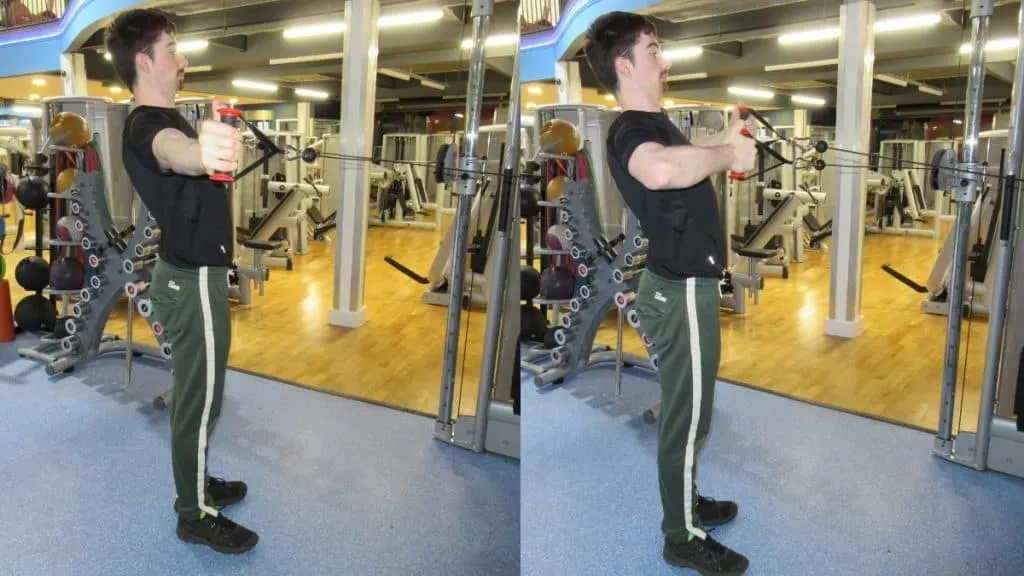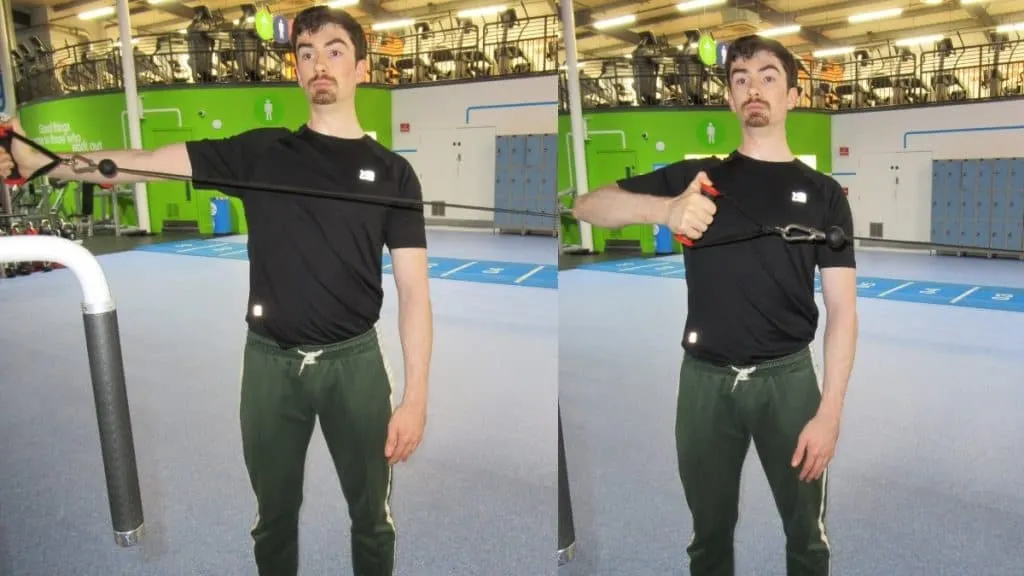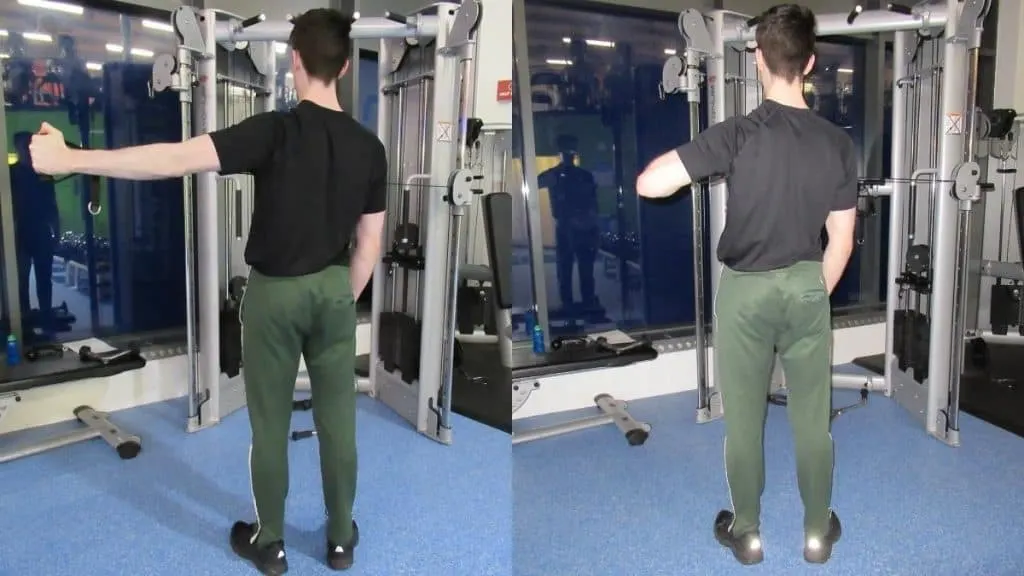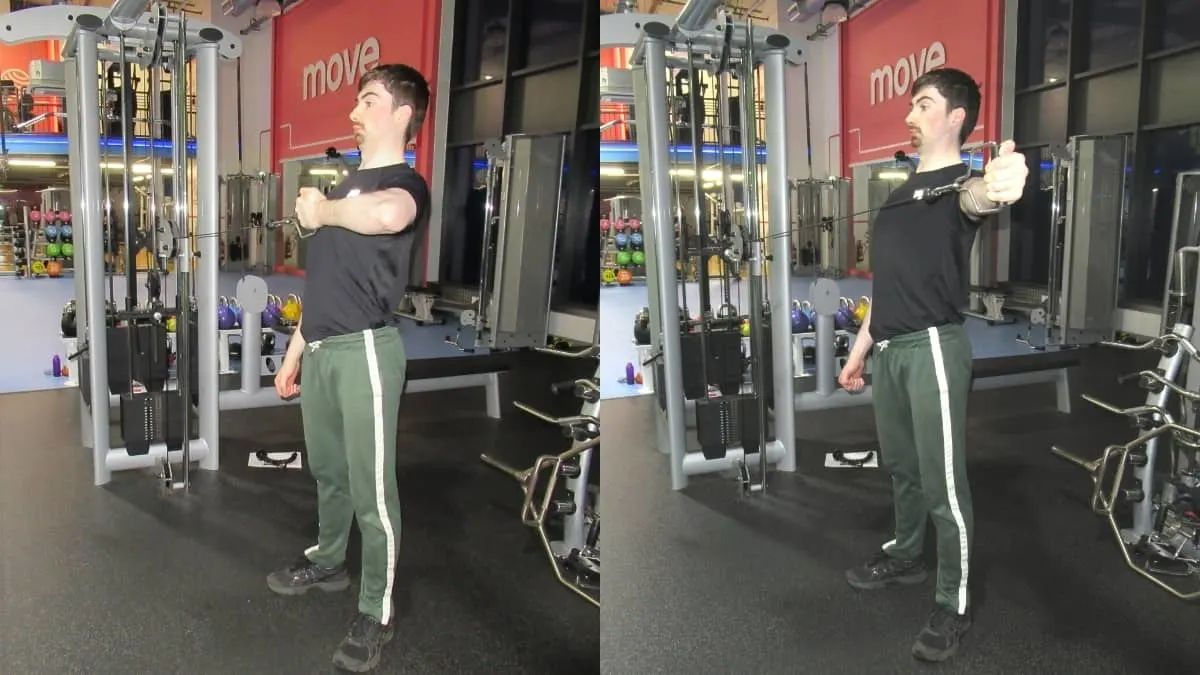The cable horizontal tricep extension promotes the use of strict, muscle-building form by putting your shoulder in a position in which it’s hard to produce force with anything other than your triceps.
Unlike a pushdown, you can’t bend forward to bring your chest into the movement. The only other muscle that you could possibly use is your rear delts, but they’re nowhere near as strong as the triceps, so they’re unlikely to take over.
You could, of course, still jerk the weight by bending your knees and hips, but that goes for any standing exercise. And besides, you can eliminate this momentum by keeping your knees locked out and your hips extended (squeezing your glutes can help in this regard).
The horizontal tricep extension is essentially the cable version of lying cross body DB tricep extensions, which means that it naturally promotes proportional upper arm development because both of your triceps will be getting similar amounts of work.
Related: Cable crossover tricep extension
Cable horizontal tricep extension exercise details
- Main Muscles: Triceps brachii muscle
- Exercise Type: Strength
- Exercise Mechanics: Isolation
- Difficulty Level: Intermediate
- Equipment Needed: Adjustable cable column, single handle attachment
How to do a horizontal tricep extension
- Position a cable pulley at chest height and connect a single handle attachment.
- Stand side-on to the machine and raise your arm up to grab the handle (as if you were doing a lateral raise). Your elbow should be parallel to the ground.
- Flex your triceps forcefully to lift the weight. Keep going until your elbow is fully extended.
- Hold the peak contraction for a split second.
- Release the contraction and allow the handle to move back across your body in a controlled manner, all while keeping your elbow and shoulder still.
- Repeat the motion with your other arm, and do 3-5 sets of 12-20 reps.
Variation: Two-arm horizontal tricep extension

If you have access to both sides of an adjustable cable machine, then you can perform the horizontal cable tricep extension with both arms to save time.
While you’ll still be training both sides independently during this variation, you won’t be able to hone in on your triceps with the same level of focus as when you do the exercise unilaterally.
Still, it’s definitely much quicker to train both arms together, and if you already have a solid mind-muscle connection, you won’t feel much (if any) of a reduction in triceps activation.
The setup for the two-arm cable horizontal triceps extension is virtually the same as it is for the one-arm version; move the pulleys to chest height, connect single cable handles, grab the handles so that your elbows are parallel to the ground, stand in the middle of the cable station, and then flex your triceps to lift the weight.
Is the horizontal cable tricep extension a good exercise?

The horizontal cable triceps extension is an excellent isolation exercise and one that’s rarely performed.
Most people perform their tricep exercises in a vertical plane of motion. But by doing an extension in a horizontal plane of movement, you reduce the ability of your other upper body muscles (especially the chest) to contribute force toward the movement. This means that your triceps receive the vast majority of the tension.
If you go heavy on the horizontal tricep extension, especially if you also do the one-arm version, then you’ll also feel a significant amount of isometric abdominal activation.
On the one hand, having to contract your abs in order to keep your torso straight will improve the rotational strength of your core.
Yet, exerting a lot of force with your core muscles may make it harder to focus on training your triceps. So if you want to do this movement for your upper arms, then it’s best to stick to high reps so that your core strength isn’t the limiting factor.
Read More: Cable concentration triceps extension
Conclusion

The cable horizontal tricep extension promotes the development of symmetrical upper arm muscles by enabling you to train each arm separately. This ensures that both of your triceps get equal amounts of stimulation, something that can help to reduce your muscular imbalances.
Since cables provide constant tension, the horizontal tricep extension really pumps up your arms because your triceps don’t get to rest until the set is over—even when you lock your elbow out, your triceps are still under tension from the pulley.
For this reason, the pump-inducing horizontal cable tricep extension is an excellent exercise for finishing off your triceps at the end of a workout because it’s particularly suited to high-rep lifting.

